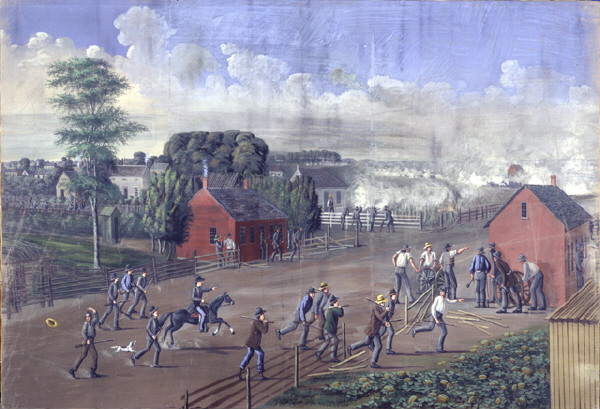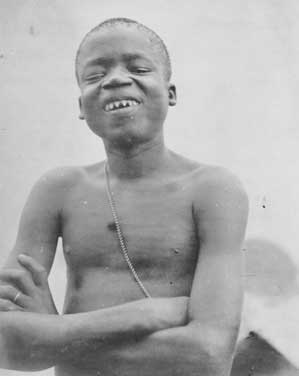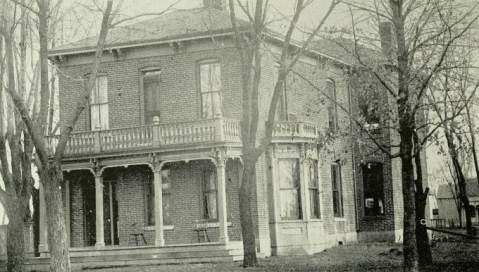8 Shocking Things You Had No Idea Happened In Missouri
Missouri has had some strange history, some of which we may not be very proud of. When we started digging for interesting facts about the state, we dug up some of the craziest things that have happened here.

When the Ku Klux Klan applied to sponsor a portion of United States Interstate 55 in St. Louis County and Jefferson County, the state could not legally refuse the sponsorship. In response, the Missouri legislature voted to name the highway section the "Rosa Parks Highway."
When Parks was asked how she felt about this honor, she is reported to have simply said, "It is always nice to be thought of."
When Parks was asked how she felt about this honor, she is reported to have simply said, "It is always nice to be thought of."

Also known as the Extermination Order, Missouri Executive Order 44 was issued in the aftermath of the Battle of Crooked River, a clash between Latter Day Saints and a unit of the Missouri State Guard in northern Ray County during the 1838 Mormon War.
The militia and other state authorities used the executive order to banish the Latter Day Saints from their lands, which in turn led to the Latter Day Saint migration to Nauvoo, Illinois.
The order wasn’t officially rescinded until 1975!
The militia and other state authorities used the executive order to banish the Latter Day Saints from their lands, which in turn led to the Latter Day Saint migration to Nauvoo, Illinois.
The order wasn’t officially rescinded until 1975!
Advertisement

22-year-old Cornealious Michael Anderson and a companion robbed a Burger King manager at gunpoint of approximately $2,000 while he was attempting to deposit the money in a night deposit box at a bank. They caught Anderson two months later, hiding in his girlfriend's apartment.
At his trial in 2000, Anderson was sentenced to a total of 13 years in prison. He left on a $25,000 bond. After many appeals, the Supreme Court of Missouri upheld the conviction in 2002. After the ruling, his bond was to have been revoked and Anderson arrested to serve his 13-year sentence. However, unknown errors in communication occurred and Missouri Department of Corrections believed he was already in prison.
The error still wasn’t discovered in 2004, when Anderson filed another appeal that actually stated that Anderson was not in prison and gave his current address at the time. Nothing happened with the appeal and for the next seven years Anderson got married, founded a company, voted, and renewed his driver’s license, all using his full name and address.
When he was scheduled for release in 2013, it was finally discovered that he was not in prison.
At his trial in 2000, Anderson was sentenced to a total of 13 years in prison. He left on a $25,000 bond. After many appeals, the Supreme Court of Missouri upheld the conviction in 2002. After the ruling, his bond was to have been revoked and Anderson arrested to serve his 13-year sentence. However, unknown errors in communication occurred and Missouri Department of Corrections believed he was already in prison.
The error still wasn’t discovered in 2004, when Anderson filed another appeal that actually stated that Anderson was not in prison and gave his current address at the time. Nothing happened with the appeal and for the next seven years Anderson got married, founded a company, voted, and renewed his driver’s license, all using his full name and address.
When he was scheduled for release in 2013, it was finally discovered that he was not in prison.
Advertisement

James Robert Scott was convicted of causing a massive flood of the Mississippi River at West Quincy, as part of the Great Flood of 1993. While he was serving 10 years in prison for an unrelated charge, investigation of the flood led to one of Scott’s friends.
The friend told the authorities that Scott had admitted to him he had broken the levee so he could strand his wife on the Missouri side of the river so he could be free to party, fish and have an affair. They found other witnesses who backed his story and Scott was eventually tried under a 1979 Missouri law that made it a crime to intentionally cause a catastrophe. Although there were several appeals, he was ultimately convicted of the crime.
He is currently serving a sentence of 20 years to life in prison at the Jefferson City Correctional Center. Although he still maintains that he is innocent, he won’t be eligible for parole until 2023.
The friend told the authorities that Scott had admitted to him he had broken the levee so he could strand his wife on the Missouri side of the river so he could be free to party, fish and have an affair. They found other witnesses who backed his story and Scott was eventually tried under a 1979 Missouri law that made it a crime to intentionally cause a catastrophe. Although there were several appeals, he was ultimately convicted of the crime.
He is currently serving a sentence of 20 years to life in prison at the Jefferson City Correctional Center. Although he still maintains that he is innocent, he won’t be eligible for parole until 2023.

Ken Rex McElroy was a resident of Skidmore in Nodaway Couny. Known as "the town bully," over the course of his life McElroy was accused of dozens of felonies, including assault, child molestation, statutory rape, arson, hog and cattle rustling, and burglary.
Although he was indicted 21 times, he was not convicted until his final crime, shooting and seriously injuring the town's 70-year-old grocer, Ernest "Bo" Bowenkamp. When he appealed the conviction and was released on bond, he engaged in an ongoing harassment campaign against Bowenkamp and his sympathizers. He appeared in a local bar armed with an M1 Garand rifle and bayonet, and later threatened to kill Bowenkamp.
The next day as he sat with his wife Trena in his pickup truck on the town’s main street, McElroy was shot to death in broad daylight. He was struck by bullets from at least two different firearms in front of a crowd of at least 30 people. To date, no one has been charged in connection with McElroy's death.
Although he was indicted 21 times, he was not convicted until his final crime, shooting and seriously injuring the town's 70-year-old grocer, Ernest "Bo" Bowenkamp. When he appealed the conviction and was released on bond, he engaged in an ongoing harassment campaign against Bowenkamp and his sympathizers. He appeared in a local bar armed with an M1 Garand rifle and bayonet, and later threatened to kill Bowenkamp.
The next day as he sat with his wife Trena in his pickup truck on the town’s main street, McElroy was shot to death in broad daylight. He was struck by bullets from at least two different firearms in front of a crowd of at least 30 people. To date, no one has been charged in connection with McElroy's death.

When Brian and Susan Trost their Weldon Spring home in 2007 and soon began seeing brown recluse spiders everywhere, stating that they "started bleeding out of the walls." When at least two pest control companies failed to exterminate the spiders, they filed a claim with their insurance company and sued the previous owners for not disclosing the infestation.
At the civil trial in St. Charles County in October 2011, University of Kansas biology professor Jamel Sandidge estimated there were between 4,500 and 6,000 spiders in the home.
Although the jury awarded the couple slightly more than $472,000, the former owners declared bankruptcy, the insurance company still didn't pay anything and the couple moved out of the home.
At the civil trial in St. Charles County in October 2011, University of Kansas biology professor Jamel Sandidge estimated there were between 4,500 and 6,000 spiders in the home.
Although the jury awarded the couple slightly more than $472,000, the former owners declared bankruptcy, the insurance company still didn't pay anything and the couple moved out of the home.

The town of Gerald wrestled for years with a methamphetamine problem. The FBI showed up, and arrests began. Houses were ransacked, and handcuffed perpetrators named names. As a result, the drug menace seemed to be finally diminishing. The arresting agent, known as "Sergeant Bill," claimed he didn’t need search warrants to enter homes because he worked for the federal government.
A local reporter who was fact checking eventually discovered that Sergeant Bill wasn’t a federal agent, but was instead Bill A. Jakob, an unemployed former security guard, former trucking company owner, former wedding minister and former small-town police officer from a nearby town.
Sergeant Bill’s misadventures made quite a mess. Three police officers who apparently had known the truth were fired, the outcome of the drug arrests were in doubt, and a multimillion-dollar federal civil rights lawsuit ensued with at least 17 plaintiffs. Politically, it stirred up many battles, including a petition seeking the impeachment of the mayor.
A local reporter who was fact checking eventually discovered that Sergeant Bill wasn’t a federal agent, but was instead Bill A. Jakob, an unemployed former security guard, former trucking company owner, former wedding minister and former small-town police officer from a nearby town.
Sergeant Bill’s misadventures made quite a mess. Three police officers who apparently had known the truth were fired, the outcome of the drug arrests were in doubt, and a multimillion-dollar federal civil rights lawsuit ensued with at least 17 plaintiffs. Politically, it stirred up many battles, including a petition seeking the impeachment of the mayor.

In 1903, an American businessman hunting Africans purchased Ota Benga from African slave traders. Ota Benga was a Mbuti pygmy from the Congo. He was brought into the United States and began being featured in exhibits. At the Louisiana Purchase Exposition in St. Louis in 1904, he was featured in an anthropology exhibit. By 1906, he was at the Bronx Zoo, being exhibited in the zoo’s Monkey House.
In the early 20th century, displays of non-Western humans as examples of "earlier stages" of human evolution were common. Racial theories were frequently intertwined with concepts from evolutionary biology. However, African-American newspapers around the nation began publishing editorials strongly opposing Benga's treatment, and the mayor was petitioned for Benga’s release.
The mayor released Benga to the custody of Reverend James M. Gordon, who supervised the Howard Colored Orphan Asylum in Brooklyn. Gordon arranged for Benga to be cared for in Virginia, paying for American clothing and for teeth caps. This allowed him to better blend into society. He was tutored in English and began to work.
He attempted to return to Africa but World War 1 restrictions on ship travel prevented him. This disappointment, as well as the inhumane treatment he had endured most of his life, caused Benga to fall into a depression.
He committed suicide in 1916 at the age of 32.
In the early 20th century, displays of non-Western humans as examples of "earlier stages" of human evolution were common. Racial theories were frequently intertwined with concepts from evolutionary biology. However, African-American newspapers around the nation began publishing editorials strongly opposing Benga's treatment, and the mayor was petitioned for Benga’s release.
The mayor released Benga to the custody of Reverend James M. Gordon, who supervised the Howard Colored Orphan Asylum in Brooklyn. Gordon arranged for Benga to be cared for in Virginia, paying for American clothing and for teeth caps. This allowed him to better blend into society. He was tutored in English and began to work.
He attempted to return to Africa but World War 1 restrictions on ship travel prevented him. This disappointment, as well as the inhumane treatment he had endured most of his life, caused Benga to fall into a depression.
He committed suicide in 1916 at the age of 32.
Had you heard these stories before? What do you think of our strange history?
OnlyInYourState may earn compensation through affiliate links in this article. As an Amazon Associate, we earn from qualifying purchases.




